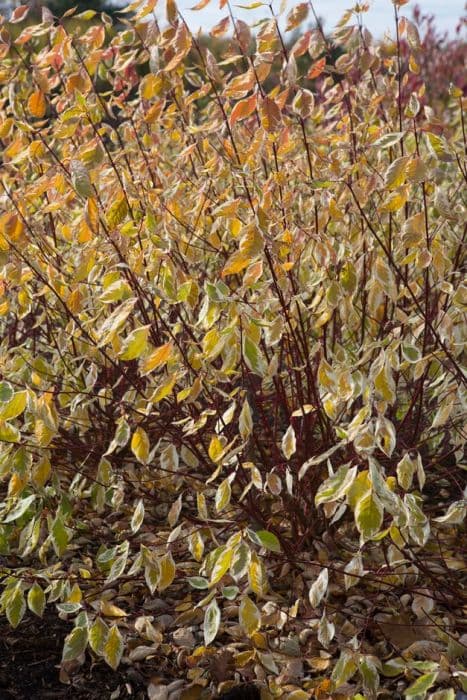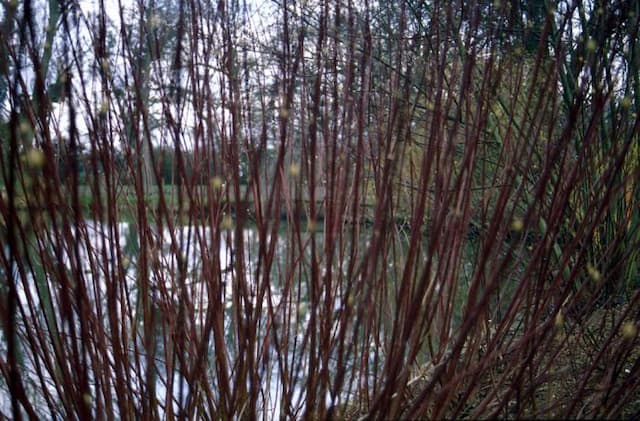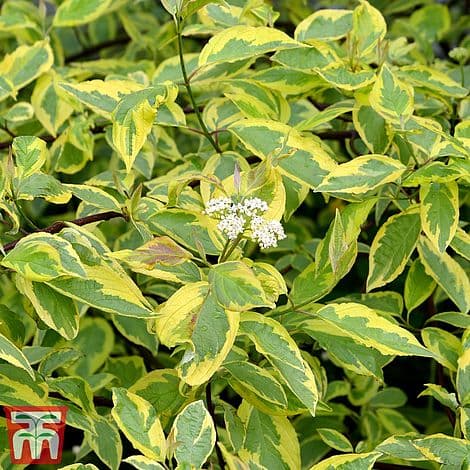Flowering dogwood Cornus florida











ABOUT
C. florida is a small tree or large shrub with large, broadly oval, mid-green leaves that turn red and purple in autumn. In late spring, clusters of small, green flowers are surrounded by conspicuous white or pink bracts, followed by rounded, orange-red fruit
About this plant
 Names
NamesFamily
Cornaceae
Benefits
 General Benefits
General Benefits1. Ornamental Value: The Cornus florida plant's showy white and pink flowers, along with its red-orange fall foliage and colorful winter stem color, make it an attractive addition to any landscape. 2. Pollinator Attraction: The Cornus florida plant's bright colored flowers are a favorite of bees, birds, and butterflies, making it a great choice for eco-friendly gardeners looking to boost pollinator populations. 3. Root Systems: The root systems of Cornus florida plants are incredibly hardy and help to stabilize soil, making them a great choice for erosion control. 4. Durability: This plant is very resilient and easy to care for, making it a great choice for those who don't have a lot of time to spend on gardening tasks. 5.Adaptability: Cornus florida plants can grow in a range of soils and climates, making them quite versatile and tolerant to changing conditions.
 Medical Properties
Medical Properties1. Anti-inflammatory: Cornus florida has been found to contain compounds that have anti-inflammatory properties, making it useful in treating inflammation-related diseases such as arthritis. 2. Antioxidant: Compounds contained in Cornus florida have been found to possess antioxidant properties, which helps protect the body from damage caused by free radicals. 3. Anti-allergy: Cornus florida extract has been found to reduce allergic reactions in both humans and animals. This makes it useful in treating allergies and other related conditions. 4. Diuretic: Cornus florida extract has been found to possess diuretic properties, making it helpful in treating fluid retention and other health conditions related to fluid imbalance. 5. Cardiovascular health: Cornus florida extract has been found to possess properties that can help improve cardiovascular health, such as by reducing blood pressure and cholesterol levels. 6. Liver health: Studies done on animals have shown that Cornus florida extract could help protect the liver from damage, making it a useful tool in treating liver conditions.
 Air-purifying Qualities
Air-purifying QualitiesCornus florida is known for its air purifying qualities. It is an evergreen that helps clean the air by removing formaldehyde, benzene, and xylene particles. It also produces oxygen, which helps make the air cleaner and fresher.
 Other Uses
Other Uses. 1. Floral Arrangements: Cornus florida is often used as a filler flower in bouquets due to its bright colors and abundant blooms. 2. Decorative Topiary: Cornus florida can be pruned into a topiary shape to add an interesting decorative element to gardens or yards. 3. Hedgerow Fence: Cornus florida can be planted with other species to create a dense hedge that provides privacy and brings a rustic beauty to outdoor settings. 4. Ground Cover: Cornus florida's attractive foliage makes it an ideal ground cover option, providing some extra greenery in areas where other plants don't grow well. 5. Bird Feeders: The berries of the Cornus florida plant are a favorite food of many birds. This makes it a great feeder-plant in the winter months.
Interesting Facts
 Feng Shui
Feng ShuiCornus florida, also known as the flowering dogwood, is a great addition to any Feng Shui decor. Placing the tree near the entryway of a home or place of business is a great way to invite in positive energy of prosperity. Alternatively, a single flowering dogwood branch can be placed near a desk or office to invite in creativity and positive luck. This tree emits a calming energy, so placing it in a living room, bedroom or office space can help to create a sense of serenity.
 Zodiac Sign Compitability
Zodiac Sign CompitabilityThe Cornus florida is associated with the sign of Aries, the first sign in the zodiac. This is because of the plant's reputation for symbolizing new beginnings, energy, initiative and ambition, as well as its ability to bring renewal and growth. This plant is a great choice for those born under the sign of Aries as its qualities embody many of the characteristics associated with this sign.
 Plant Symbolism
Plant SymbolismCornus florida, commonly known as the flowering dogwood, is an ornamental tree native to the eastern United States. The tree is associated with a wide range of symbolic meanings. In some Native American cultures, it is said to represent the four directions, strength, protection, and healing. Its flowering period in spring is seen as a symbol of renewal, while its bright red berries are said to symbolize courage and fertility. The tree's spreading branches are also said to symbolize the unceasing protection of the Great Spirit. On a practical level, it has been used as herbal medicine and to make dye, while its strong, dense timber has been used to make furniture and canoe paddles.
 Water
Waterof plants Cornus florida, commonly known as flowering dogwood, should be watered deeply and infrequently to prevent root rot. A thorough watering once every 7-10 days is usually sufficient for flower dogwood, depending on the weather and soil type. Be sure to check the soil for moisture prior to each watering, as the plant does not appreciate "wet feet." To water flower dogwood, water the soil deeply around the base of the tree until the soil is completely saturated. Avoid overhead watering, as water droplets on the leaves may cause fungal diseases. A deep, thorough watering should apply approximately 1” of water to the soil.
 Light
LightCornus florida thrives best in bright, indirect sunlight. It should be placed in a spot that receives several hours of morning sun and afternoon shade. Avoid exposing the plant to the hot afternoon sun as this can cause damage.
 Temperature
TemperatureThe best lighting conditions for Cornus florida are full sunlight for at least 6 to 8 hours per day. In the summer, temperatures should range between 65 and 85 degrees Fahrenheit, and in the winter, temperatures should range between 20 and 40 degrees Fahrenheit.
 Pruning
Pruninggreen To prune a Cornus florida, use sharp pruning shears and trim off any dead, diseased, or damaged stems appearing in the spring. Pruning can also be done to control shape, control size, reduce excessive branching, and to promote flower production. Prune during the dormant season, usually late winter or early spring. When pruning, avoid removing more than 1/3 of the branches each year. Over-pruning will stunt the development of the tree.
 Soil
SoilThe best soil mix for Cornus florida consists of 1 part coarse sand, 1 part loam, and 1 part peat moss. The soil should have a pH between 6.0 and 6.5. Additionally, adding a slow-release fertilizer to the soil can provide a nutrient boost for your Cornus florida.
 Repotting
Repottingbold Yes, you should repot Cornus florida periodically, ideally every 2-3 years.
 Humidity & Misting
Humidity & MistingThe optimal relative indoor humidity for a Cornus florida (flowering dogwood) is best kept at around 50-60%. To increase the humidity, place the pot in a shallow pan filled with water and pebbles or mist the leaves regularly. To decrease the humidity, use a fan pointed towards the plant and make sure it is not near a heat source.
 Suitable locations
Suitable locationsIndoor
The best conditions for Cornus florida to grow indoors include a minimum temperature of between 65° Fahrenheit and 75° Fahrenheit, a well-drained potting soil that is allowed to dry out between waterings, bright, indirect light, and a pot that is at least 8 inches (20 cm) in diameter.
Outdoor
Cornus florida does best in full sunlight, with temperatures between 50-90°F. It should also have well-draining soil with a pH of 5.5-7.5. The ideal soil should be continually moist, yet well aerated. If soil is too wet, it should be mulched. Cornus florida needs to be planted in an area with good air circulation and should be pruned to the desired size, with at least 6-8 feet of space between trees.
Hardiness zone
Plant Hardiness Zones
 Life cycle
Life cycleCornus florida is a deciduous flowering shrub native to the east coast of the United States. It typically grows to 12-15 feet in height and width producing clusters of 4-petaled white flowers in the spring. The flowers produce small, dark purple fruits which develop by summer. After pollination, the flowers produce small, berrylike drupes that mature to blue-black in fall. In late summer and autumn, the leaves turn beautiful shades of yellow, purple, and red. In the winter, the leaves are shed and the bark flakes off to reveal brown to reddish-brown bark and branches. The plant is hardy in USDA Hardiness Zones 5 to 9.
 Propogation
PropogationPropogation of the Cornus florida plant can be accomplished through the use of softwood cuttings, bud and stem cuttings, grafting, air-layering, and by seed. Softwood cuttings are taken in late spring or summer and should be placed in a rooting medium at a temperature between 70-75°F. The cuttings should be about 4-8 inches long and should remain moist until rooting has occurred, which will usually take around 4-6 weeks. Bud and stem cuttings should be taken in the spring and fall and placed into a rooting medium at a temperature between 68-74°F. The cuttings should be between 2-4 inches and after 4-6 weeks when roots have developed, the plants should be ready to be transplanted. Grafting can be done in late winter when the plants are dormant. A whip and tongue is the most common method and consists of taking two branches and cutting them at an angle and them interlocking them, then tying them together with tape. It is important that the two branches come from the same species. It takes up to a month for the grafts to heal and they should be kept in a dry and warm place. Air layering is done in late winter when the plants are dormant and consists of wounding the stem and wrapping it in moist sphagnum moss, then wrapping the moss in plastic to keep it moist. The moss should be kept moist and when ignored roots have developed, the stem can be cut off and planted as a separate plant. Seedlings can also be planted in late summer or early fall. The seeds should be lightly covered with soil and kept moist until germination has occurred. The young plants should be grown out in rows at least 8 inches apart and in full sun or partial shade.









